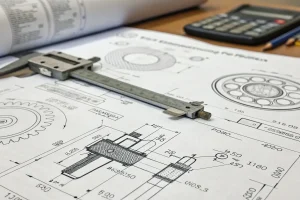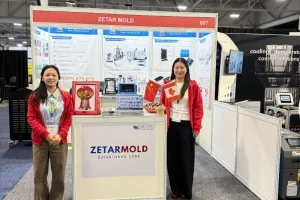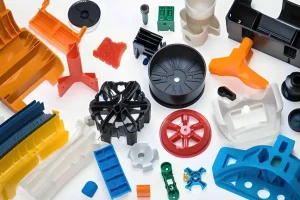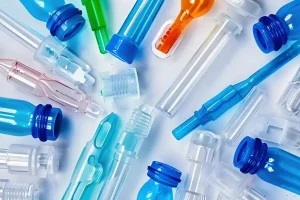What is the mold temperature in injection molding? This is a question that many people have, but don’t know where to find the answer to.
In this blog post, we will discuss what mold temperature is and how it affects your injection molded parts.
Mold temperature is the most important variable in injection molding – regardless of the type of plastic being molded, the temperature that forms the base of the mold surface must be ensured.
A hot mold surface keeps the plastic surface liquid long enough to build pressure inside the cavity.
If the cavity is filled and the cavity pressure can press the soft plastic against the metal before the frozen skin appears to harden, then the cavity surface replicates highly.
On the other hand, if plastic entering the cavity at low pressure is suspended, no matter how briefly, then its slight contact with the metal can cause staining, sometimes referred to as gate smearing.
For each type of plastic and plastic part, there exists a mold surface temperature limit beyond which one or more undesirable effects can occur (e.g., components can spill burrs).

What are the effects of higher mold temperatures?
Higher mold temperatures mean less resistance to flow. On many injection molding machines, this naturally means faster flow through runners, gates, and cavities because the injection flow control valves used do not correct for this change, and faster filling causes higher effective pressure in the gates and cavities. This can cause overflow burrs.
Since the hotter model does not freeze the plastic that enters the overflow edge area before high pressures are developed, the melt can overflow around the ejector bar and spill into the parting line gap.
This indicates the need for good injection rate control, and some modern flow control programmers can indeed do this.
Typically, an increase in mold temperature will reduce the amount of plastic that has a condensation layer in the cavity morning, allowing the molten material to flow more easily within the cavity, resulting in greater part weight and better surface quality.
At the same time, the increase in mold temperature also results in increased part tension strength.

How should I choose the temperature of the mold in injection molding?
The temperature of the mold affects the flow behavior of the plastic melt when it is filled and influences the performance of the plastic product.
The temperature of the mold determines the cooling rate of the melt. The faster the cooling process rate, the faster the temperature of the melt decreases, which increases the viscosity and makes the flow difficult, resulting in increased injection pressure loss, lower effective mold filling pressure, and even causing underfilling.
Usually, the mold temperature should be determined according to the properties of the processed plastic, the performance requirements of the product, the shape and size of the product, and the process conditions of the molding process, etc. for comprehensive consideration.

(1) For plastics with higher viscosity, such as PC, it is appropriate to use higher mold temperature; while plastics with small viscosity, such as PA, PS, etc., use lower mold temperature.
As the mold temperature decreases, the solidification rate and cooling rate of plastic increase, which is beneficial to provide productivity and shorten the production cycle.
(2) To make no deformation when demolding, the mold temperature should usually be lower than the glass transition temperature of the plastic or the temperature that is less likely to cause deformation of the product, but the demolding temperature of the product should be slightly higher than the mold temperature. The molding temperature is related to the wall thickness and residual stress of the product.
(3) Mold temperature on plastic crystallization, molecular orientation, product stress, and various mechanical new energy. Low mold temperature is conducive to the crystallization of polymer.
For thick-walled products, due to the mold filling time and cooling time being long, if the mold temperature is too low, it will cause the formation of a vacuum bubble and shrinkage inside the product, and cause internal stress, so thick-walled products should not use low mold temperature.

Mold Temperature Regulation System
The plastic injection molding process is the injection of molten plastic into the mold cavity at high pressure, after which the molten material is cooled in the mold cavity and cured below the heat deflection temperature of the plastic.
This process is realized by the temperature difference between the melt and the mold. Since different molding materials require different mold temperatures (mold temperature should be lower than the heat deflection temperature of the plastic part), if the mold temperature is too high or too low, it will affect the quality and production of the plastic part.
A. Too high: overflow; shrinkage; long curing time of plastic parts, long injection molding cycle, and low productivity.
B. Too low: poor flowability of the melt increased stress on the plastic part, and defects such as poor filling, fusion marks, lack of material, and lack of gloss on the surface.
C. Uneven :deviation in shrinkage rate, deformation of plastic parts, etc.
So the mold design must consider a cooling or heating device to regulate the mold temperature and injection cycle.
(1) When the molding material temperature is insufficient to make the mold reach the mold temperature required for molding, then the heating device should be considered.
(2) When molding plastic parts with wall thickness greater than 20mm, then the heating device should be considered.
(3) When the material temperature makes the mold temperature exceed exceedsld temperature required for molding, then the cooling device should be considered.
(4) Generally when molding thermoplastic, the mold needs to be cooled; for thermosetting plastic, the mold needs to be heated.

Purpose of mold temperature regulation
A. Shorten the molding cycle: keep below the heat deformation temperature of the plastic by effective cooling means.
B. Improve the quality of plastic parts: to prevent the deformation of demold.
C. Adapt to special needs: when injecting crystalline plastitor to control the crystallinity of the plastic and improve its overall performance, it is generally required to maintain a higher mold temperature; large molds need to be preheated before injection molding; local heating of the mold for special needs; heating of the hot runner system, etc.
Ways to insulate molds
Many molds, especially engineering thermoplastics, operate at relatively high temperatures, such as 80 degrees Celsius or 176 degrees Fahrenheit.
If the mold is not insulated, as much heat can easily be lost to the air and the injection molding machine as is lost to the injection cylinder. To insulate the mold from the machine plate and if possible, insulate the surface of the mold.
If considering a hot runner mold, try to reduce the heat exchange between the hot runner section and the cooled injection molded part. Such a method can reduce energy loss and preheating time.
1. Temperature measurement
Temperature measurement and control are very important in injection molding. Although it is relatively simple to perform these measurements, most injection molding machines do not have sufficient temperature pick-up points or lines.
On most plastic injection molding machines, the temperature is sensed by thermocouples. A thermocouple consists of two different wires connected at the end. If one end is hotter than the other, a tiny electrical signal will be generated; the more it is heated, the stronger the signal.
2. Temperature control
The thermocouple is also widely used as a melt temperature control system sensor. On the mold temperature controller, the desired melt temperature is set and the display of the sensor will be compared to the temperature generated at the set point.
In this simplest system, the power is turned off when the molding temperature reaches the setpoint and turned back on when the temperature drops. This system is called on/off control because it is either on or off.
3. Melt temperature
The melt glue temperature is very important and the shot cylinder temperature used is only a guide. The melt temperature can be measured at the injection nozzle or by using the air injection method.
The temperature setting of the injection cylinder depends on the melt temperature, screw speed, back pressure, injection volume, and injection cycle.

Summary
You should start with the lowest setting if you have no experience in processing a particular level of plastic. The injection cylinders are divided into zones for ease of control, but not all are set to the same temperature.
If operating for long periods of time or at high temperatures, set the mold temperature control in the first zone to a lower value, which will prevent premature melting and shunting of the plastic.
Make sure that the hydraulic fluid, hopper closers, molds, and injection cylinders are all at the actual temperature before injection begins.










